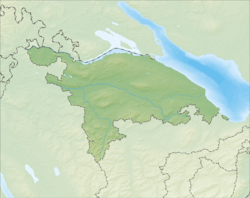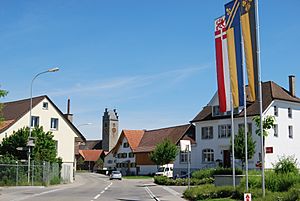Lommis facts for kids
Quick facts for kids
Lommis
|
||
|---|---|---|
|
||
| Country | Switzerland | |
| Canton | Thurgau | |
| District | Münchwilen | |
| Area | ||
| • Total | 8.61 km2 (3.32 sq mi) | |
| Elevation | 475 m (1,558 ft) | |
| Population
(Dec 2020 )
|
||
| • Total | 1,243 | |
| • Density | 144.37/km2 (373.9/sq mi) | |
| Postal code |
9506
|
|
| Surrounded by | Affeltrangen, Bettwiesen, Stettfurt, Thundorf, Tobel-Tägerschen, Wängi | |
Lommis is a small town, also called a municipality, in Switzerland. It's located in the canton of Thurgau, within the Münchwilen district. It's a place with a long history and a mix of farming and modern jobs.
Contents
History of Lommis
Lommis was first written about in the year 824. Back then, it was called Loubmeissa. Another part of the town, Kalthäusern, was mentioned later in 1296.
Around the year 854, a famous St. Gallen monastery received land in the Lommis area. Later, around 1200, the area of Lommis was like a special territory or Herrschaft. It was controlled by the Reichenau Abbey and the Counts of Toggenburg. A family of unfree knights, called Ministerialis, who served a powerful lord, owned Lommis.
In 1443, a person named Petermann of Raron bought the village. After changing hands a few more times, it became part of Fischingen Abbey in 1599. It stayed under the Abbey's control until 1798.
The village church was likely built a very long time ago, in the High Middle Ages. It was part of the parish of Affeltrangen. We know there was a priest there in 1214. In 1529, the village adopted the new Protestant faith during the Reformation. However, the local lord brought back the Catholic Mass in 1532. From 1648 to 1966, the church was a shared church. This meant both Protestants and Catholics used it.
In the past, people in Lommis mainly worked in farming and grew vineyards until about 1900. They also extracted peat, a type of fuel, until 1918. A mill was built in 1625, along with a sawmill. From 1810 to 1839, there was a cotton mill in Lauchetal. Later, an embroidery factory opened in 1900, and a shoe factory in 1933. After 1918, the dairy industry became more important. Today, Lommis has industries like construction, light manufacturing (wood and aircraft electronics), and jobs related to the airport since 1962. The town's population grew quickly after 1970.
Geography of Lommis
Lommis covers an area of about 8.6 square kilometers (3.3 square miles). A large part of this land, about 62.8%, is used for farming. Forests cover about 26.7% of the area. Buildings and roads make up about 8.5% of the land. A small part, 0.7%, is rivers or lakes. The remaining 1.6% is unproductive land.
Most of the built-up area is for industrial buildings (4.9%). Houses and other buildings make up 0.5%, and roads are also 0.5%. Parks and sports fields cover 2.6%. In the forested areas, 25.6% is dense forest, and 1.2% has orchards or small groups of trees. For farming land, 58.8% is used for growing crops. About 4.0% is used for orchards or vineyards.
Lommis is located in the Münchwilen district, in the Lauche valley near Matzingen. The municipality includes the villages of Lommis, Kalthäusern, and Weingarten. The old municipality of Lommis existed from 1803 to 1994. In 1995, Lommis merged with Weingarten to form the new municipality we know today.
People and Population
Lommis has a population of about 1,049 people. As of 2008, about 9.0% of the people living in Lommis were from other countries. Over ten years, from 1997 to 2007, the population grew by 9.3%. Most people in Lommis (94.3%) speak German. Italian is the second most common language (2.1%), followed by Albanian (1.1%).
In 2008, the population was almost evenly split between males (49.4%) and females (50.6%). There were 474 Swiss men and 55 non-Swiss men. There were 500 Swiss women and 41 non-Swiss women.
The population of Lommis is growing. In 2008, there were 6 babies born to Swiss citizens and 1 baby born to non-Swiss citizens. In the same year, 3 Swiss citizens passed away. Overall, the number of Swiss citizens increased by 3, and the number of foreign residents increased by 1. Some people also moved away from Switzerland. In total, the Swiss population increased by 9 people, and the non-Swiss population increased by 12 people. This means the population grew by 2.0% in 2008.
Looking at the age groups in 2009:
- 10.8% of the population are children aged 0-9 years old.
- 17.6% are teenagers aged 10-19.
- 9.9% are young adults aged 20-29.
- 10.0% are adults aged 30-39.
- 21.8% are adults aged 40-49.
- 14.7% are adults aged 50-59.
- 8.3% are seniors aged 60-69.
- 4.6% are seniors aged 70-79.
- 1.8% are seniors aged 80-89.
- 0.4% are 90 years old or older.
In 2000, there were 354 homes in Lommis, with about 2.7 people living in each home. Most homes (87.6%) were single-family houses. The average rent for an apartment in Lommis in 2000 was about 1148.55 Swiss francs (CHF) per month.
In the 2007 national election, the most popular political party was the SVP, which received 53.57% of the votes. Other popular parties were the CVP (15.49%), the FDP (9.8%), and the Green Party (9.66%). About 52.1% of eligible voters participated in the election.
Here's how the population has changed over time:
| Year | Population Lommis |
Population Kalthäusern |
|---|---|---|
| 1850 | 356 | 102 |
| 1900 | 341 | 79 |
| 1950 | 350 | 63 |
| 1990 | 487 | 58 |
| Year | Population, Lommis | |
| 2000 | 962 | |
Economy and Jobs
In 2007, Lommis had a very low unemployment rate of 0.87%. This means almost everyone who wanted a job had one.
In 2005, there were 77 people working in the primary economic sector. This includes jobs like farming and forestry. There were 35 businesses in this area. Another 163 people worked in the secondary sector. These jobs involve making things, like in factories. There were 17 businesses in this sector. Finally, 82 people worked in the tertiary sector. These are service jobs, like in shops, offices, or schools. There were 30 businesses in this sector.
In 2000, 664 people lived in Lommis and worked. About 46.4% of these people traveled outside Lommis for their jobs. However, 169 people came into Lommis to work. There were a total of 525 jobs in the municipality. Most people (58.1%) used a private car to get to work, while 4.8% used public transportation.
Religion in Lommis
Based on the 2000 census, about 42.1% of the people in Lommis were Roman Catholic. Another 40.3% belonged to the Swiss Reformed Church (a Protestant church). A small number of people belonged to other Christian churches (5.41%) or the Orthodox Church (0.21%). There was also a small number of people who were Islamic (1.04%) or Jewish (0.10%). About 8.11% of the population said they didn't belong to any church, or were agnostic or atheist. A few people (2.60%) did not answer the question about their religion.
Education in Lommis
Education is important in Lommis. About 71.8% of adults aged 25-64 have completed either non-mandatory upper secondary education (like a vocational school) or higher education (like a university or a Fachhochschule, which is a university of applied sciences).
Lommis has its own primary school district. In the 2008/2009 school year, there were 126 students.
- There were 25 children in kindergarten, with an average class size of 12.5 students. Most of them (56.0%) were girls.
- The primary school has two levels: lower and upper.
- In the lower primary level, there were 50 children. About 62.0% were girls.
- In the upper primary level, there were 51 children. About 47.1% were girls.
The average class size for primary school was 20.2 students.
Images for kids
See also
 In Spanish: Lommis para niños
In Spanish: Lommis para niños






